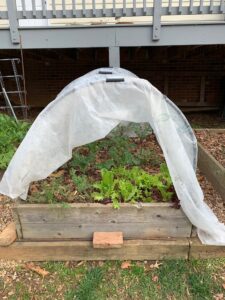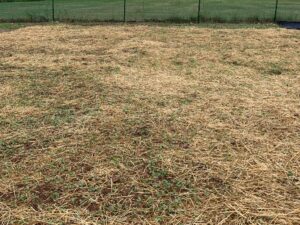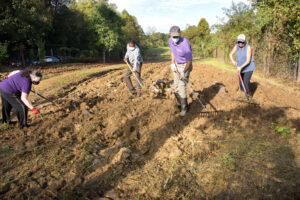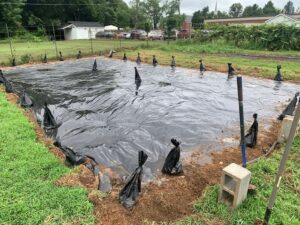September is a busy month for committed edibles gardeners. Key tasks include harvesting, cleaning up spent crop vegetation, final planting for fall and early winter harvest, and cover cropping or mulching beds that are finished for the season. We’ll briefly touch on each area.
Harvesting
Many summer vegetable plantings will be reaching the end of their productive lives. It is a judgement call on when to stop the harvest and remove plants. It depends on plant condition, pest impact, and intentions for that garden space’s next phase. Harvesting when fruits and vegetables are young can help keep plants going a bit longer. Items like tomatoes can be picked as soon as color starts to change to minimize pest damage, while maintaining most “summer tomato” qualities. Generally, ripening tomatoes off the vine goes best when the fruit is kept out of direct sunlight in moderate temperatures. Adding ethylene to their environment can speed things up. Placing tomatoes in a paper bag with a banana is a commonly suggested approach.
This is also the time to optimize late season herb harvest. Pinching flowers will help prolong leaf production. Plants can be dug up and potted, or cut and rooted to be moved inside.
Planting
Excellent vegetable planting and harvesting guidance is contained in the VCE publication Virginia’s Home Garden Vegetable Planting Guide. Albemarle county gardeners should follow guidance for hardiness Zone 7b.
As the Guide indicates for zone 7b, some vegetables can be planted in September. Broccoli and cabbages may be planted until about 9/10. Collards, kale, Swiss chard, kohlrabi and turnips can be planted until 9/20. Finally, lettuces, mustard, radishes and spinach are ok to plant into October. The earlier they are planted the better since growth will slow as days shorten and temperatures drop. Keep time-to-harvest in mind when planting. Our expected first frost in Hardiness Zone 7b is 10/25 to 11/5, so frost sensitive crops want to be planted early enough to have time to mature before the first freeze arrives.
Readers who are not from Virginia can check your hardiness zone on the nationwide USDA Hardiness Zone map by entering your zip code in the search box.

Many pests will continue attacking plants until frost. Physically removing pests and spraying plants can help control them. Row covers can protect new plantings from fall predators. Row covers can also extend the growing and harvest times for the cooler weather crops. For more mature plants that are already susceptible to pest damage, row covers are not a good idea until after frost kills the pests. A row cover can provide a 4-5 °F temperature benefit and extend the growing season for a variety of greens, including spinach and lettuces. Check out the article Using Row Covers in the Garden by the UNH Extension.
If you have been struggling with pests this year, a great all-purpose source for pest identification and treatment options is the Home Grounds and Animals: 2025 Pest Management Guide from the VA Cooperative Extension.
Preparing Beds for Winter
If you are finished for the year, this is the time to clean up, amend and protect soil as winter approaches.
Fall is a great time to do a soil test. Identifying needed amendments and adding them now, provides a head start for strengthening the soil by spring. In the Charlottesville/Albemarle County area soil test kits and instructions are available from the Extension office at 460 Stagecoach Rd. I suggest including checking the organic matter content of the soil (a $4 extra charge), a good indicator of soil health.
Next, thoroughly clean up the garden area. Removing spent plant material is essential to minimize wintering-over pests and disease-carrying vegetation. It is best to bag and dispose of any diseased plant materials. Clean material can be chopped up and composted or spread on the soil and allowed to decompose over winter.
Once beds are cleaned, best practices are to either cover crop or mulch the growing beds. Prior to that, smooth the beds and add amendments recommended by the soil test.
Next choose whether to cover crop or mulch. While cover cropping is best, adding a few inches of organic mulches like compost, chopped leaves or leaf mold and/or aged wood chips, will protect the soil during the winter and add organic matter over time.

Cover crops bring several benefits, including building soil structure, reducing erosion and compaction, weed suppression, adding organic matter, and in the case of legumes, fixing atmospheric nitrogen for plant use. There are a couple of basic cover crop choices: winter-killed and winter-hardy.
- Winter-killed cover crops die out after a few hard frosts, but their root and surface biomass help hold the soil and they can be used as mulches, composted or tilled under in spring. Oats, field peas, forage radishes, and rapeseeds are common types.
- Winter-hardy cover crops will either grow through or go dormant in winter but resume growth in spring. They should be cut in spring after flowering but prior to going to seed, with the greens composted, used as mulch, or, if you insist on tilling, tilled into soil as a green fertilizer. If greens are tilled in, allow 2 or 3 weeks after tilling for decomposition prior to planting. Winter-hardy choices include winter rye, winter wheat, hairy vetch, Austrian winter peas, and crimson clover.
- Mixed Covers: Regenerative farmers report benefits from mixed cover crops that provide a diversity of soil benefits. A mix used successfully on Piedmont Master Gardener projects includes crimson clover, forage radishes, and annual ryegrass. If planted by mid-September, the radishes will penetrate deeply into the soil before being killed by frost, opening the soil and depositing valuable organic matter. The clover and ryegrass will go dormant in winter and revive in spring, adding nitrogen and root mass to the soil. They can be cut during the flowering stage, prior to seed formation, and allowed to rest for a couple of weeks before planting. The cut vegetation can be used as a mulch or removed and composted.
- Cover cropping blends well with converting your beds to “No-Till” gardening. For more info on this proven effective and growing soil management practice check-out the article Smart Gardening: Converting to No-Till for Home Gardeners from the U of Nebraska Extension.
Preparing New Beds

If you are planning a new garden or garden expansion next year, fall is a good time to begin preparing soil. Tilling to remove or bury surface vegetation, adding organic matter, and mulching or cover cropping prior to winter are good preparation. The picture above shows a new garden area operated by New Roots Charlottesville, an arm of our local International Rescue Committee, a PMG community garden partner. The surface grass in the bed has been tilled under and volunteers are preparing the surface for a winter hardy cover crop planting. Additionally, based on a soil test, lime was spread over the area to raise the low pH, and reduce soil acidity.
More information on cover crops can be found in Cover Crops and Try Cover Cropping: A Guide for Home Gardeners from the Maryland and NC State Extensions respectively.
Another option, which doesn’t require digging or tilling, is sheet mulching. It involves moistening the base soil, covering it with an organic barrier like newspaper or flattened corrugated boxes, then adding six or more inches of a mix of organic materials including leaves, soil, compost or aged wood chips, topped off with a few inches of straw to manage moisture and reduce weeds. If done in the fall it should be ready for direct planting in the spring, although the decomposition rate is a function of the materials used. Chunky, woody materials take longer to get ready than mulched and decomposed matter. Find detailed guidance in the video Sheet Mulching: Lawn to Garden Bed in 3 Steps from the Penn State Extension.
Winter Weed Management via Occultation

If aggressive weed growth is an issue that needs attention, consider occultation. The photo above shows a silage tarp covering a section of a Cultivate Charlottesville garden that has struggled with aggressive growth of bermuda grass that inhabited the area for decades prior to garden formation. The tarp is held down by sand bags and edges are dug with soil spread along tarp edge to prevent light penetration and reduce rhizome spreading. It will be left in place until spring planting and will hopefully reveal much reduced weed life when removed. Weeds were string trimmed prior to putting the tarp in place. If you have a similar issue, this can be a good way to gain on it before spring planting. Solarization is a similar process using a clear cover rather than a dark colored tarp. Solarization lets more sun through but tends to get the soil hotter and can offer more support for pest and disease control.
General Tips
Garlic is best planted during October. Purchase seed bulbs in September before local retailers sell out. Internet suppliers offer more variety for experimenters or connoisseurs. The article Growing Garlic – Fall Planting from the Penn State Extension provides a concise summary of garlic selection, planting, and care.
Give your indeterminate (vining, long-lived) tomato plants one last feeding. Compost tea or fish emulsion should give them the extra energy they need to make an end-of-season push. Pinching off small green tomatoes and any new flowers will channel the plant’s energy into ripening the remaining full-size fruit.
Don’t cut asparagus ferns (stalks) until they turn brown and dormant. This is typically later in the fall. Best to give the plant time to store photosynthesized nutrients in its roots to fuel spring re-growth.

If you’ve been lax in your garden documentation this year, tour your garden and make notes on varieties grown, successes, challenges, and chores, to assist garden management next year. Make a sketch showing the location of this year’s plants to guide rotation next spring, an important pest and disease management practice.
Continue to weed the garden to prevent the weeds from going to seed and germinating next spring. Keep the strawberry patch weed free. Every weed you pull will reduce labor next spring.
Pick pears when green and hard ripe. Store in a cool, dark place to ripen.
Check peach tree trunks and just below the soil at their base for borer holes. Probe the holes with a wire to kill the borers.
Remove two-year-old canes from raspberry and blackberry plants at ground level to reduce overwintering of disease. Fertilizers containing potassium, phosphorus, and magnesium or calcium can be applied but do not cultivate or irrigate at this time of the year.
Fall weed control around fruit trees is crucial because weeds act as hosts to overwintering insects.
Plant lavender seeds in the fall for spring germination.
In any case, enjoy the fall gardening season. Cooler weather, reflecting on the past season and making preparation for a better next year can be very satisfying. My garden was a wonderful source of food and pleasure this year. I hope it was the same for you. See you next month at The Garden Shed.
Sources:
“Gardening by Month–September,” Missouri Botanical Garden, http://www.missouribotanicalgarden.org/gardens-gardening/your-garden/help-for-the-home-gardener/advice-tips-resources/gardening-by-month/september.aspx
“Monthly Horticulture Tip Sheets — Herbs, September,” Va. Coop. Ext. Albemarle/Charlottesville, https://albemarle.ext.vt.edu/content/dam/albemarle_ext_vt_edu/files/hort-tip-sheets/9-14-herbs.pdf
“Monthly Horticulture Tip Sheets — Fruit and Nuts, September,” Va. Coop. Ext. Albemarle/Charlottesville, https://albemarle.ext.vt.edu/content/dam/albemarle_ext_vt_edu/files/hort-tip-sheets/9-14-fruits-nuts.pdf
Season Extenders and Growing Fall Vegetables (psu.edu): Advice on growing fall vegetables and how to protect plants from the cold and pests.